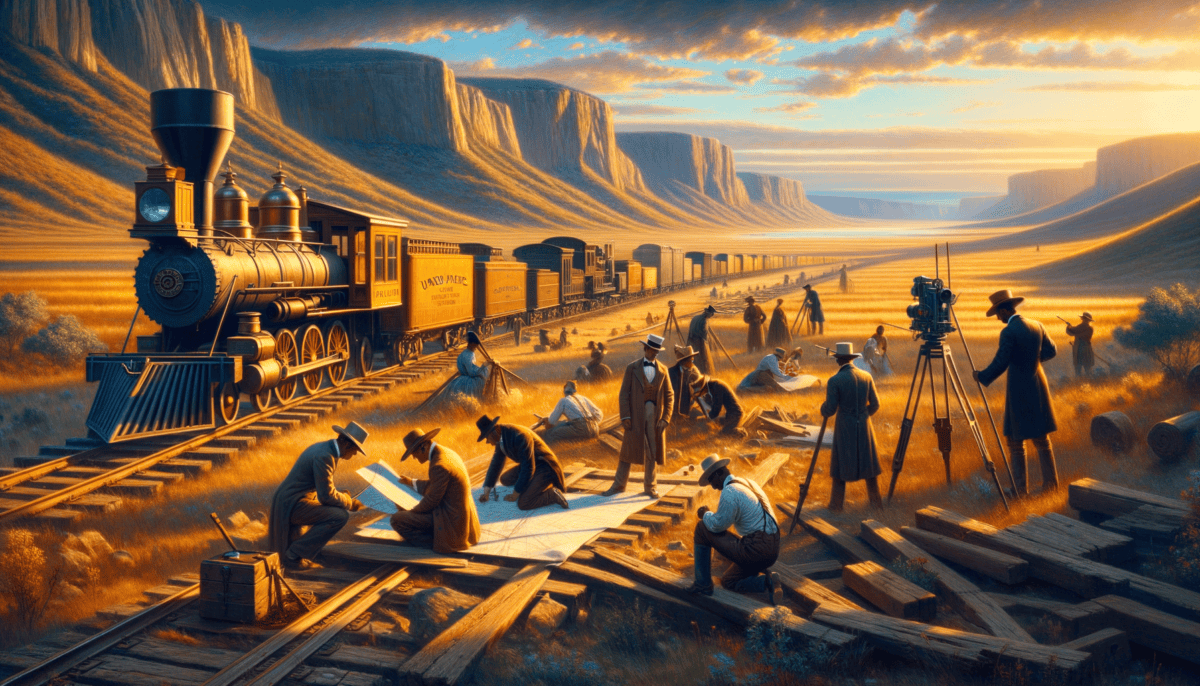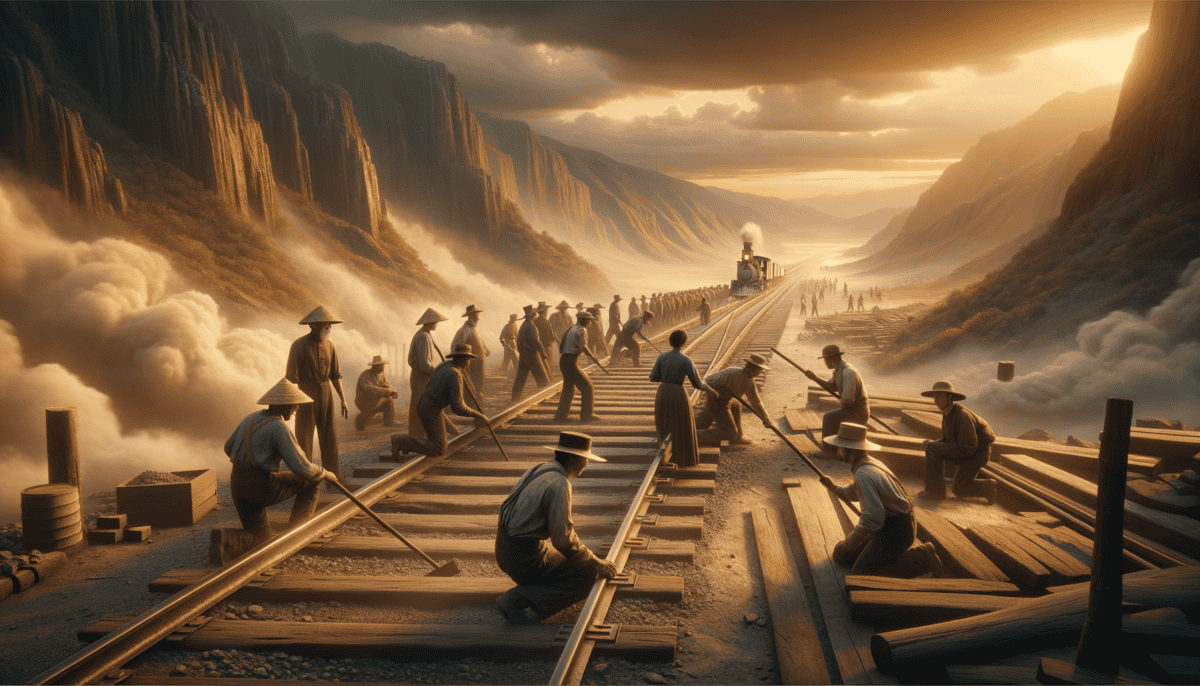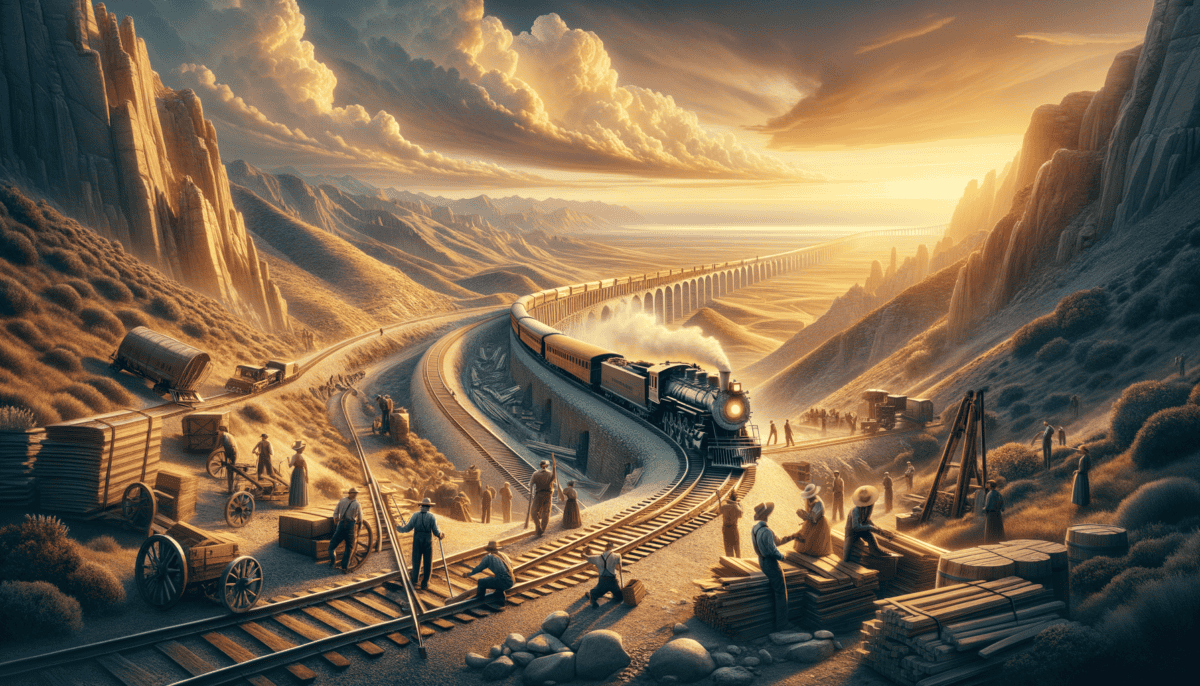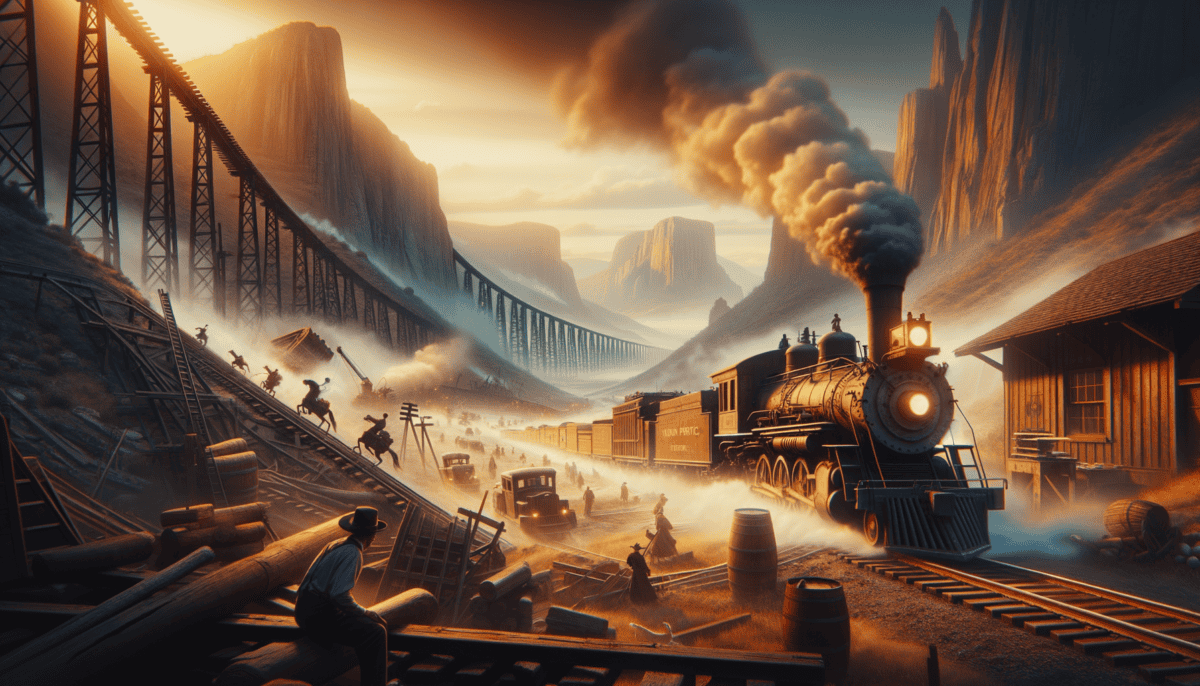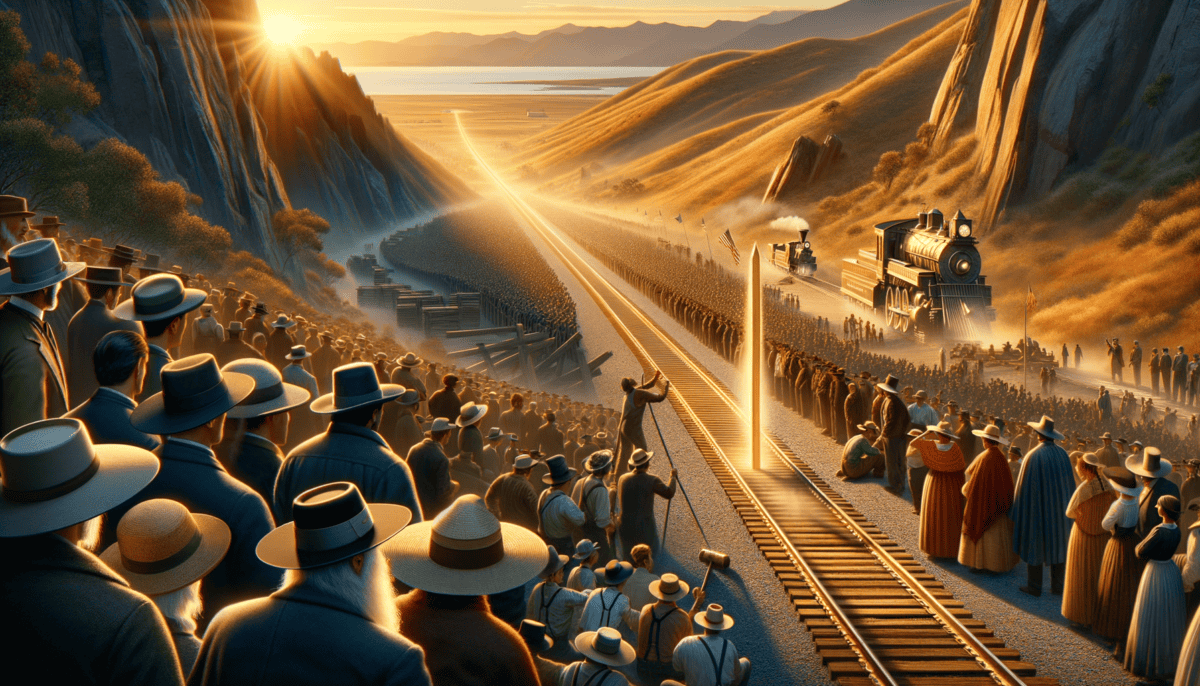A Dream Across America
Tommy sat wide-eyed at his grandfather's feet, staring at the old sepia photograph of men standing proudly next to a massive steam engine. The year was 1862, and America was about to embark on its greatest adventure yet.
"Grandpa, tell me again about the big dream!" Tommy bounced excitedly on his cushion.
Grandpa John smiled, his weathered face crinkling with joy. "Well, young man, before the railroad, it took six whole months to travel from New York to California. Can you imagine that? That's like waiting from Christmas to summer vacation!"
Tommy's jaw dropped. "Six months? But why so long?"
"You see, people had to travel by horse and wagon across dangerous mountains, hot deserts, and wide rivers. Some brave folks even sailed all the way around South America by boat!" Grandpa John spread his arms wide to show the distance.
"But then," Grandpa continued, lowering his voice dramatically, "some very smart people had a magnificent idea. What if we could build a railroad that went all the way across America?"
Tommy leaned forward. "Was it President Lincoln's idea?"
"President Lincoln was one of the biggest supporters! In 1862, he signed a very important paper called the Pacific Railway Act. It was like giving permission to start the biggest building project anyone had ever seen!"
The Dreamers and Planners
"Many people thought it was impossible," Grandpa John explained, pulling out another photograph showing men in tall hats studying maps. "They said, 'You can't build tracks through mountains! The snow will block the way!'"
But there were brave dreamers who didn't listen to the doubters. These were people like:
- Theodore Judah – The brilliant engineer who first mapped the route through the mountains
- Collis Huntington – A shop owner who became a railroad leader
- Leland Stanford – A future governor who helped lead the project
- Grenville Dodge – A clever surveyor who found the best paths for the tracks
"The best part," Grandpa said with a twinkle in his eye, "was that this wasn't just about building a railroad. It was about connecting people from all across our great nation."
Tommy traced his finger along an old map. "But Grandpa, how did they know where to build it?"
"Ah! That's where the surveyors came in. They were like explorers who went ahead to find the best path. They had to look for flat land when possible, figure out how to cross rivers, and find ways through or around mountains."
Young Tommy stood up and pretended to look through an imaginary telescope. "Like this, Grandpa?"
"Exactly like that! And they had to be careful. Every decision they made would affect thousands of workers and millions of dollars."
Grandpa John pulled out a small piece of iron rail from an old wooden box. "This," he said solemnly, "is a piece of the original track. Feel how heavy it is?"
Tommy's small hands wrapped around the cold metal. "Wow! And they needed lots of these?"
"Millions of them! Plus wooden ties to hold them, spikes to secure them, and bridges to cross valleys and rivers. It was going to be the biggest thing America had ever tried to build."
The setting sun cast long shadows through the window as Grandpa John carefully returned the rail piece to its box. "But that was just the beginning of the story, Tommy. The real adventure was about to start – when they actually began laying those first tracks…"
Building the Iron Path
The morning sun cast long shadows across the prairie as two groups gathered at opposite ends of America. In the east, the Union Pacific Railroad team stood ready in Omaha, Nebraska. In the west, the Central Pacific Railroad crew assembled in Sacramento, California.
“Mr. Stanford, sir!” young Billy, a messenger boy, called out. “The supplies have arrived!”
Leland Stanford, the leader of the Central Pacific, smiled. “Excellent! Now we can truly begin.”
• 2,800 wooden ties
• 350 rails
• 7,040 spikes
“How will we build through all this land?” Billy asked, looking at the vast empty space before them.
“One rail at a time, my boy. One rail at a time.” Stanford pointed to the growing pile of supplies. “First, we need strong workers.”
Finding the Right Workers
Getting enough workers was hard. Many men had left to fight in the Civil War. The Central Pacific tried something new – they hired Chinese workers. These men were strong, skilled, and worked very hard.
“Look how fast they lay those rails!” Billy exclaimed, watching the Chinese workers move with practiced speed.
“They’re the best workers we could ask for,” Stanford nodded. “And over in the east, the Union Pacific has Irish immigrants helping them build their part.”
The Daily Challenge
Each day brought new problems to solve. The workers faced:
- Hot sun and cold snow
- Not enough food and water
- Dangerous cliffs and deep valleys
- Heavy rails and tools to carry
“Watch this, Billy,” called out Mr. Strobridge, the construction boss. He showed how the workers had created a system:
First, surveyors marked where the track should go. Then, graders leveled the ground. Next, teams laid the wooden ties. Finally, the rail team placed the heavy iron rails on top.
Help from the Government
“But Mr. Stanford,” Billy asked one day, “how can we pay for all of this?”
Stanford pulled out a map marked with squares. “See these boxes? The government gave us land on both sides of the track. For every mile we build, we get 20 square miles of land. We can sell this land to help pay for the railroad.”
The government also gave money for each mile of track laid. The harder the land was to build on, the more money they received.
Racing Against Time
As winter approached, everyone worked faster. They knew snow could stop their progress, especially in the mountains.
“Billy, take this message to the crew,” Stanford handed over a note. “Tell them we need to finish this section before the first snowfall.”
Racing through the camp, Billy saw hundreds of men working together like a well-oiled machine. Chinese workers swung hammers in perfect rhythm. Supply wagons rolled steadily back and forth. Surveyors peered through their instruments, planning the next day’s work.
That evening, as the sun set behind the hills, Billy sat with some of the workers around a campfire. An old railroad man named Joe pulled out his harmonica and began to play.
“You know, Billy,” Joe said between songs, “we’re not just laying track here. We’re building America’s future. Every rail we place brings the east and west a little bit closer together.”
Billy looked up at the stars, imagining the day when trains would run all the way across the country. The sound of hammers still rang in the distance as the night crew worked by lamplight. Tomorrow would bring new challenges, but for now, he was proud to be part of this amazing project.
A Meeting of Cultures
The sun blazed overhead as Ming Wei wiped sweat from his brow. He had been working on the railroad for six months now, alongside hundreds of other Chinese workers. Nearby, Patrick O’Brien and his crew of Irish laborers hammered spikes into wooden ties.
Two Teams, One Goal
“Pass the water, would ya?” Patrick called out to Ming Wei. Though they spoke different languages, they had learned to communicate through gestures and shared words.
Ming Wei handed over his water jug. “Good water,” he said in careful English. Patrick smiled and took a drink.
Life in the Camps
At night, two different camps came alive. In the Chinese camp, the smell of rice and tea filled the air. Workers played games with tiles and wrote letters home.
In the Irish camp, the sound of fiddles and singing rang out. Stories were shared around campfires, and letters were written to families far away.
“Why do they stay separate?” asked Tommy, Patrick’s young son who helped carry water to the workers.
“We’re different, lad,” Patrick explained. “But look at how we work together during the day. That’s what matters.”
Hard Work, Harder Lives
The work was dangerous. Ming Wei remembered the day when they had to lower workers down steep cliffs in baskets to plant explosives. The Chinese workers were chosen because they were lighter and had experience working with ropes.
• Exploding dynamite
• Falling rocks
• Extreme weather
• Heavy equipment accidents
“Brave men,” Patrick would say, watching the Chinese workers swing in their baskets. “Braver than most.”
Meeting the Locals
One day, a group of Native Americans rode into the camp. They weren’t happy about the railroad crossing their lands.
“Chief says this is their hunting ground,” the translator explained to the foreman.
Ming Wei watched as the railroad bosses talked with the tribal leaders. Some tribes helped the railroad by providing food and knowledge about the land. Others fought against it, trying to protect their homes.
Learning from Each Other
Over time, the workers began sharing more than just work. Ming Wei taught Patrick’s crew how to use chopsticks. Patrick showed Ming Wei’s team how to play cards.
“Look here,” Patrick said one evening, showing Ming Wei a trick with the hammer. “If you swing it like this, it’s easier on your back.”
Ming Wei nodded and showed Patrick how his team tied special knots that made lifting rails safer.
Building More Than Rails
Tommy often sat between the two camps, watching both groups. He learned to count in Chinese from Ming Wei and Irish songs from his father.
“Papa,” Tommy said one night, “it’s like we’re building two things – a railroad and a bridge between people.”
Patrick hugged his son. “That’s right, lad. That’s exactly right.”
As winter approached, both camps worked faster. The Chinese workers showed amazing skill in the mountains, while the Irish excelled on the plains. Each group brought their own strengths to the massive project.
One evening, Ming Wei shared his tea with Patrick’s crew. As they sat together under the stars, they didn’t need words to understand each other. They were all part of something bigger than themselves – they were building America’s future, one rail at a time.
Mountains and Mysteries
The Sierra Nevada mountains loomed ahead like giant sleeping dragons. Engineer James Evans stood at their base, squinting up at the snow-capped peaks. “These mountains,” he said to his team, “are our biggest challenge yet.” ️
Nature’s Giant Wall
The workers stared at the massive rock walls before them. Some peaks reached higher than 14,000 feet! Ming Wei, who had become one of the lead workers, remembered his grandmother’s stories about moving mountains in China.
“One small piece at time,” he said confidently. “Mountain cannot stop us.”
The Big Dig
Patrick wiped frost from his beard. “Never seen anything like this,” he muttered. The workers had to dig tunnels through solid granite. They used new tools called steam-powered drills.
“Watch this!” Tommy called out, excited to see the steam drill in action. The machine roared like an angry bear, shooting steam into the cold mountain air.
The work was slow. Some days, they only moved forward a few inches. Other days, they couldn’t work at all because of snow and ice.
Winter’s Challenge
Snow fell thick and heavy in the mountains. The workers built wooden shelters called “snow sheds” over the tracks to protect them.
“It’s like building a long wooden house for the train,” Tommy explained to his friend Little Cloud, a Native American boy who often visited the camp.
• Deep snow
• Freezing temperatures
• Avalanches
• Icy tracks
Breakthrough!
After months of drilling and blasting, something amazing happened. Two teams drilling from opposite sides of the mountain met in the middle!
“We did it!” shouted James Evans. The tunnel was perfect – the two sides matched up almost exactly. It was like threading a needle through a mountain!
The workers celebrated together. Ming Wei shared special moon cakes he had saved, while Patrick taught everyone an Irish victory dance.
Crossing the Desert
On the other side of the mountains lay the Nevada desert. It was a different kind of challenge – hot, dry, and endless.
“At least we can see where we’re going now,” Patrick joked, wiping sweat from his face.
The teams had to carry water for miles. They learned tricks from Native Americans about finding hidden springs and staying safe in the heat.
New Tools, New Ways
To help move faster, the workers invented new tools. They made special carts that could lay track quickly. They created better ways to break rocks and move earth.
“Look how far we’ve come,” Tommy said one evening, looking back at the mountains they had conquered.
James Evans smiled. “And look how far we’ll go,” he said, pointing to the horizon. The railroad was pushing forward, mile by mile, through some of the toughest land anyone had ever tried to build on.
As the sun set behind the mountains, the workers gathered around their campfires. They had faced nature’s biggest challenges and won. The impossible was becoming possible, one day at a time. ⭐
Racing to Victory
The morning sun painted the prairie gold as two groups of workers rushed to lay tracks. On one side, the Union Pacific team hammered away. On the other, the Central Pacific crew worked just as fast. ♂️
A Friendly Fight
“Ten miles of track today!” shouted Tommy from the Union Pacific side. The Central Pacific workers heard this and smiled. Ming Wei called back, “We’ll do eleven!”
Working Together, Racing Apart
Even though they were racing, the teams helped each other. When the Central Pacific ran low on nails, the Union Pacific shared their extra supplies.
“We may be racing,” Patrick said, passing boxes to Ming Wei, “but we’re all building the same railroad.”
New Ways to Build Fast
The teams got very clever about building quickly. They made special “track-laying machines” that could put down rails super fast. ️
“Watch this!” James Evans called out. His new machine could lay track pieces like a kid placing toy train tracks – but these were real and huge!
• Building tracks ahead of time
• Using wheeled carts to move supplies
• Having teams work in special groups
• Creating assembly lines for faster work
The Big Push
As spring arrived, both teams could see they were getting closer. The gap between their tracks got smaller every day.
“Look!” Little Cloud pointed from his horse. “The iron roads are almost touching!”
The race made everyone work harder. Some days, workers stayed up late by lantern light, determined to finish one more section. ️
More Than Just a Race
Tommy noticed something special happening. “We’re not just building a railroad anymore,” he said to James Evans. “We’re connecting the whole country!”
He was right. Every new mile of track meant more towns could connect. Farmers could send food to cities. People could travel to see their families.
The Final Miles
As they got closer to meeting in the middle, excitement grew. News reporters came to watch. People sent telegrams asking for updates.
“My family back east can’t believe how fast we’re moving,” Patrick said, reading a letter from home.
Ming Wei nodded. “Soon they can come see for themselves – on our railroad!”
Almost There
By late spring, the teams could see each other’s camps. They were building toward a place called Promontory Summit in Utah.
“Just a few more miles!” James Evans announced one evening. The workers cheered. After years of hard work, the final piece of their giant puzzle was almost in place.
That night, both camps celebrated together. Irish songs mixed with Chinese music. Native American friends joined the party. Everyone knew they were part of something bigger than themselves.
As stars filled the sky, Tommy looked at the tracks stretching east and west. “Tomorrow,” he whispered, “we make history.” ⭐
Unity at Last
The morning of May 10, 1869, dawned bright and clear at Promontory Summit, Utah. Hundreds of people gathered to watch history happen. The air buzzed with excitement!
The Big Meeting
“Look at all these people!” Tommy exclaimed, watching crowds arrive by horse and wagon. Reporters with cameras set up their equipment. Telegraph operators got ready to share the news.
Ming Wei stood proudly with his Central Pacific teammates. “We built half a country of railroad,” he smiled. “Now we join them together!”
A Golden Moment
Leaders from both railroad companies stepped forward. In their hands, they held a special golden spike. It would be the last spike hammered into the railroad.
“This spike connects east to west,” announced Leland Stanford, holding up the shining spike. Sunlight made it sparkle like a star. ✨
Little Cloud watched from his horse. “The iron horse now runs from sunrise to sunset,” he said softly.
The Final Connection
Everyone held their breath as the golden spike lined up with its hole. With one mighty swing of the hammer – CLANG! The railroad was complete!
Cheers erupted! Hats flew into the air! Some people cried happy tears. Telegraph operators clicked out the message: “DONE!” to the whole country.
Dreams Come True
James Evans hugged his fellow workers. “We did it! We really did it!” Patrick and Ming Wei shook hands, remembering all their hard work together.
“Now my family can visit anytime,” Tommy said happily. “And I can go see them too!”
A New America
The railroad changed everything. Towns grew along the tracks. Farmers could send food across the country. People could travel to new places easily.
“This is just the beginning,” James Evans said, watching the first regular train cross the joined tracks. “Think of all the adventures people will have now!”
Looking Back, Moving Forward
As the sun set on that special day, the workers remembered their journey. They thought about the mountains they’d crossed, the friendships they’d made, and the dream they’d built together.
The Transcontinental Railroad wasn’t just tracks of iron and wood – it was proof that people working together could do amazing things. It showed that big dreams could come true with hard work and teamwork.
Little Cloud spoke for everyone when he said, “The iron horse now connects all people, all lands. The future is here.”
And he was right. The railroad they built that day still helps people travel across America, reminding us that when we work together, we can build bridges to tomorrow.


